“March 19, 2012 was the first rehearsal for the Victory Day Parade at the training ground in Alabino (near Moscow, Moscow Military District). Since the end of February troops and vehicles from various units and formations of the Armed Forces began arriving to Alabino training ground. The first rehearsal included only military vehicles. During the ride the average speed of vehicles is 12 km/h, the distance depending on the type of vehicle from 12 to 15 meters”. – Vitaly Kuzmin
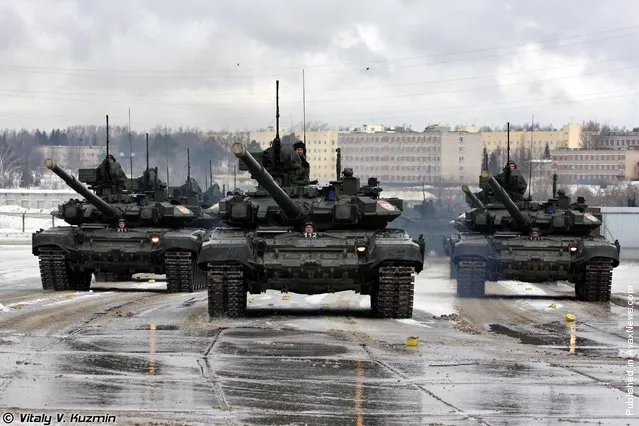
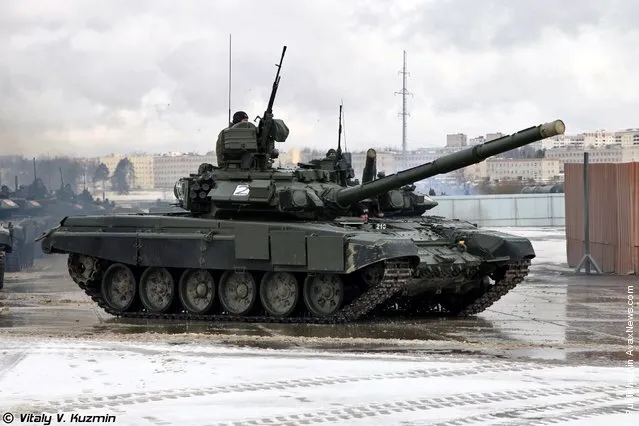
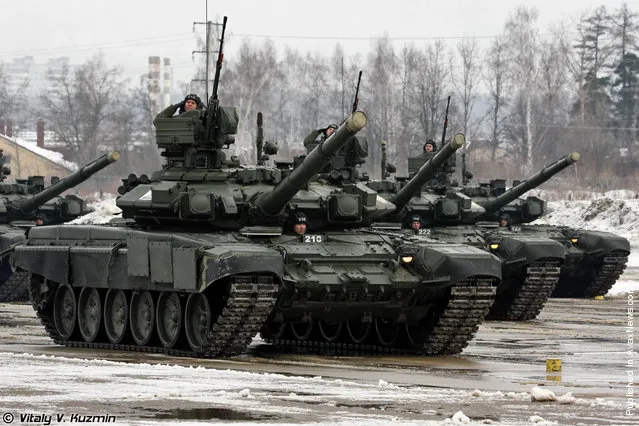
T-90A. The T-90 is a Russian third-generation main battle tank that is a modernisation of the T-72 (it was originally to be called the T-72BU, later renamed to T-90). It is currently the most modern tank in service with the Russian Ground Forces and Naval Infantry. Although a development of the T-72, the T-90 uses a 125mm 2A46 smoothbore tank gun, 1G46 gunner sights, a new engine, and thermal sights. Standard protective measures include a blend of Steel, Composite armour, and Kontakt-5 explosive-reactive armor, laser warning receivers, Nakidka camouflage and the Shtora infrared ATGM jamming system. The EMT-7 electromagnetic pulse (EMP) creator is used in testing but not fitted to T-90s in active service. It is designed and built by Uralvagonzavod, in Nizhny Tagil, Russia. From 2011 T-90 is not purchased for the troops of Russia, the troops are waiting for the development of a unified chassis Armata by 2015. (Photo by Vitaly Kuzmin)
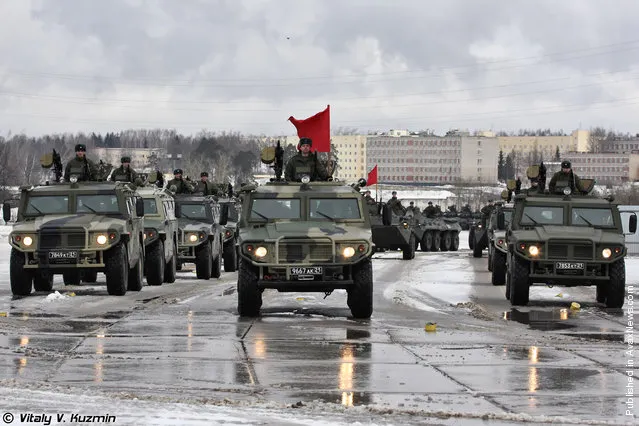
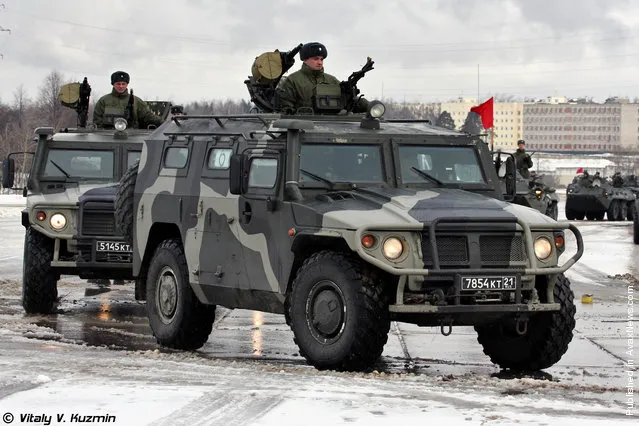
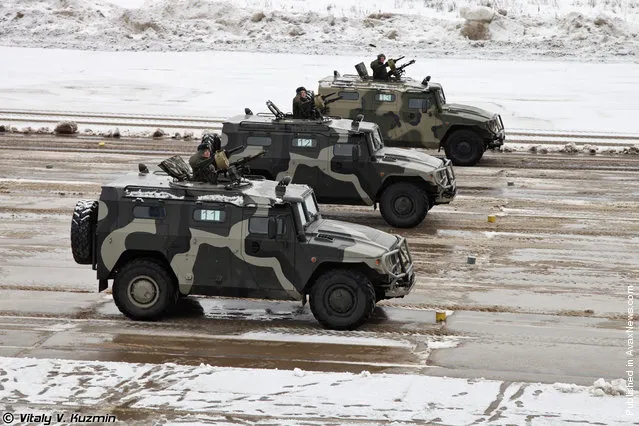
GAZ Tigr armored vehicle. The GAZ-2975 “Tigr” (Tiger) is a Russian high-mobility multipurpose military vehicle, manufactured by Military Industrial Company LLC (GAZ Group division). It is the military version of the GAZ-2330 “Tigr”. It is equipped with a powerful diesel, turbocharged, air-cooled engine and five-speed manual transmission. Independent torsion suspension, telescopic shock absorbers and regulated-pressure tires ensure exceptional cross-country ability, top speed of 90 km/h over rough terrain and up to 150 kph on the road. The Tiger can ford water up to 1.3 meters deep. Its chassis can support various specialized bodies emphasizing armor, passenger capacity, cargo, etc. The Tigr can carry as many as 10 passengers. (Photo by Vitaly Kuzmin)
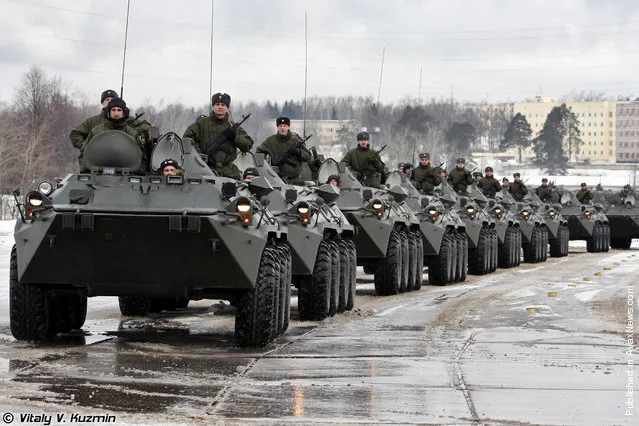
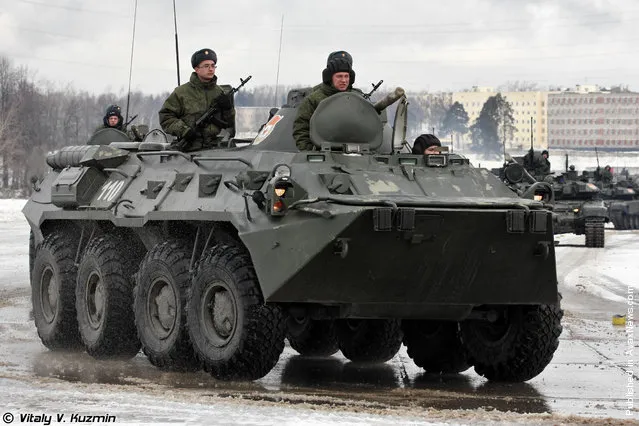
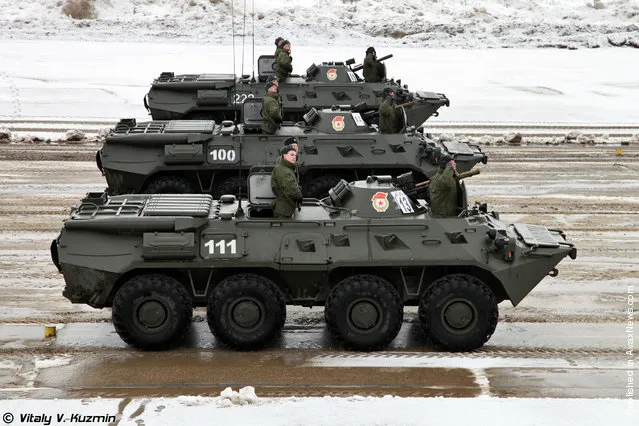
The BTR-80 is an 8x8 wheeled amphibious armoured personnel carrier (APC) designed in the Soviet Union. Production started in 1986 and replaced the previous versions, BTR-60 and BTR-70 in the Soviet army. The Soviets based the BTR-80 on the BTR-70 APC. It has a single 260-hp, V-8 turbocharged, water-cooled, diesel engine, an improvement over the twin gasoline engines installed in the BTR-60 and BTR-70 vehicles. The reconfigured rear portion of the hull accommodates a new, single engine. The Soviets removed the roof chamfers of the modified BTR-70, raised the rear, and squared off the rearward-sloping engine compartment. Standard equipment include TNPO vision blocks, optical devices TNP-B and TKN-3 for the driver and commander, an OU-3GA2M infra-red search light, six 81 mm smoke grenade launchers 902V “Tucha”, a radioset (R-173 or R-163-50U), an intercom and hydrojets. (Photo by Vitaly Kuzmin)
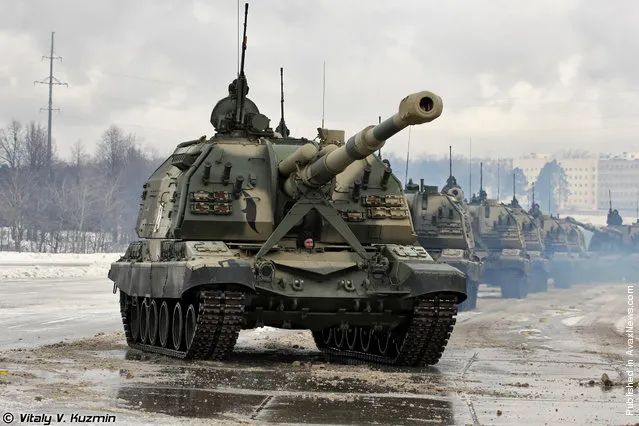
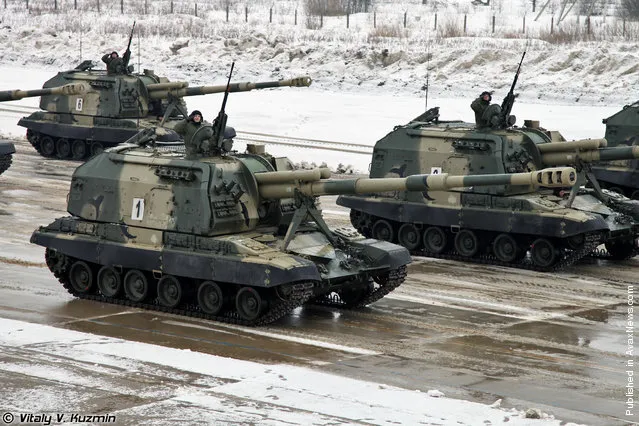
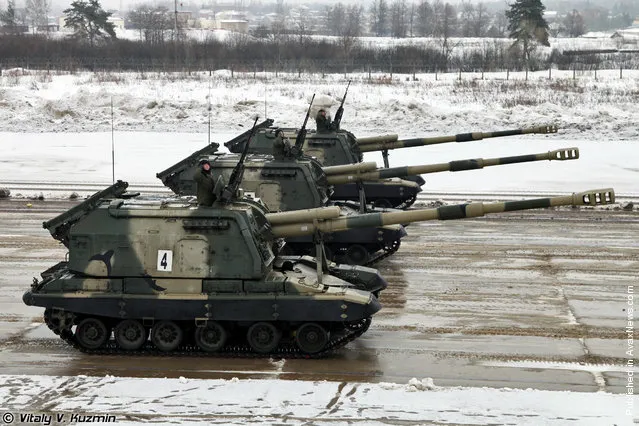
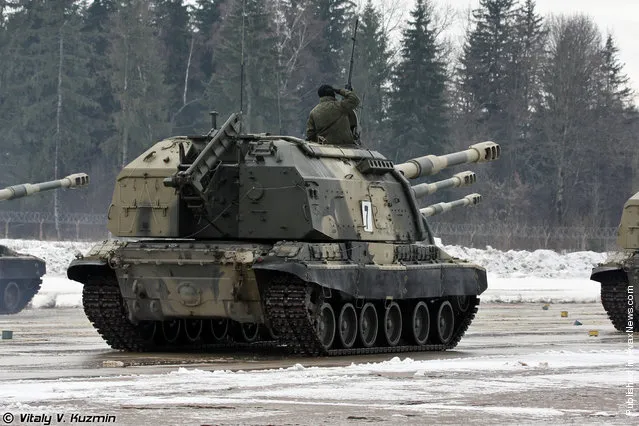
The 2S19 “MSTA-S” (after the Msta River) is a self-propelled 152 mm howitzer designed by Russia/Soviet Union, which entered service in 1989 as the successor to the SO-152. The vehicle is based on the T-80 tank hull, but is powered by the T-72's diesel engine.
The Msta is a modern howitzer designed for deployment either as an unarmored towed gun, or to be fitted in armored self-propelled artillery mountings. Current production of the towed model is designated Msta-B, while the self-propelled model is the Msta-S (also known by the GRAU index 2S19).
Development of the 2S19 started in 1985 under the project name Ferma. The prototype was known as Ob'yekt 317. The 2S19's standard equipment consists of a semi-automatic laying system 1P22, an automatic loader, an NBC protection system, passive night vision device for the driver, a wading kit, a dozer blade, a smoke generator and 81mm smoke grenade launchers, 1V116 intercom system and a 16 kW generator AP-18D. In 2008 the Russian armed forces ordered an improved model with an automated fire control system.
The 2A64 ordnance of the 2S19 can fire the following types of ammunition, among others: HE (24.7 km), HEAT-FS, HE-BB (28.9 km), HERA (36 km), smoke, chemical, tactical nuclear, illumination and cargo (ICM). The laser-guided round “Krasnopol” (of the 9K25 system) can also be launched, as well as the shorter “Krasnopol-M” which fits into the automatic loader. (Photo by Vitaly Kuzmin)
The Msta is a modern howitzer designed for deployment either as an unarmored towed gun, or to be fitted in armored self-propelled artillery mountings. Current production of the towed model is designated Msta-B, while the self-propelled model is the Msta-S (also known by the GRAU index 2S19).
Development of the 2S19 started in 1985 under the project name Ferma. The prototype was known as Ob'yekt 317. The 2S19's standard equipment consists of a semi-automatic laying system 1P22, an automatic loader, an NBC protection system, passive night vision device for the driver, a wading kit, a dozer blade, a smoke generator and 81mm smoke grenade launchers, 1V116 intercom system and a 16 kW generator AP-18D. In 2008 the Russian armed forces ordered an improved model with an automated fire control system.
The 2A64 ordnance of the 2S19 can fire the following types of ammunition, among others: HE (24.7 km), HEAT-FS, HE-BB (28.9 km), HERA (36 km), smoke, chemical, tactical nuclear, illumination and cargo (ICM). The laser-guided round “Krasnopol” (of the 9K25 system) can also be launched, as well as the shorter “Krasnopol-M” which fits into the automatic loader. (Photo by Vitaly Kuzmin)
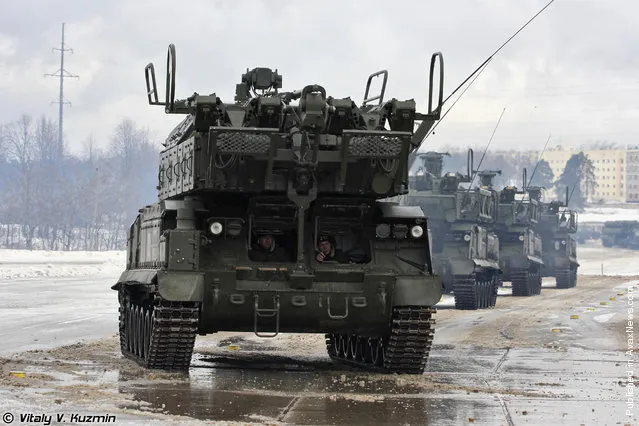
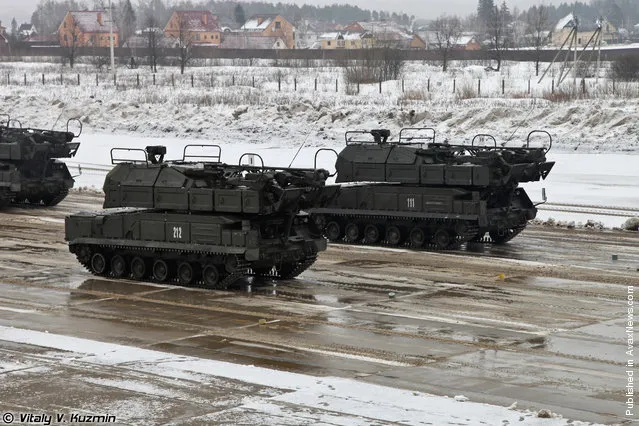
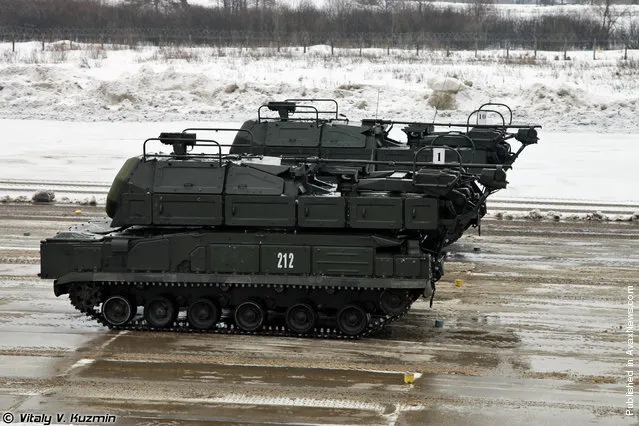
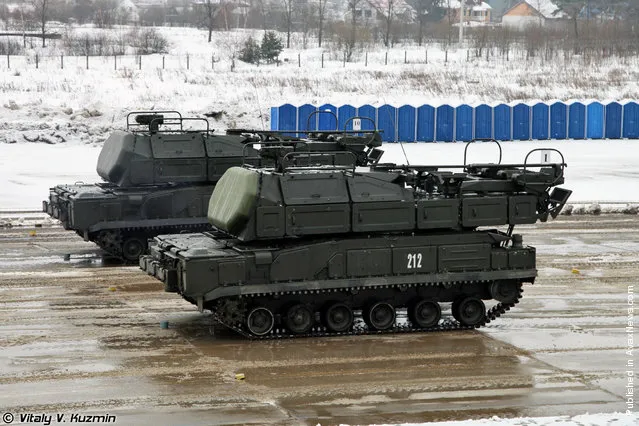
9A317 self-propelled launching vehicle for Buk-M2 air defence system. (Photo by Vitaly Kuzmin)
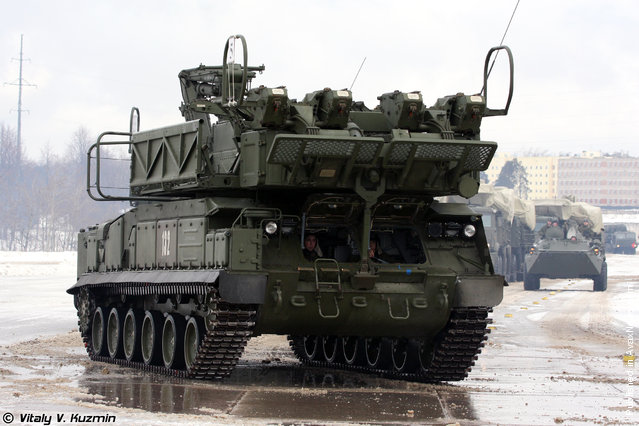
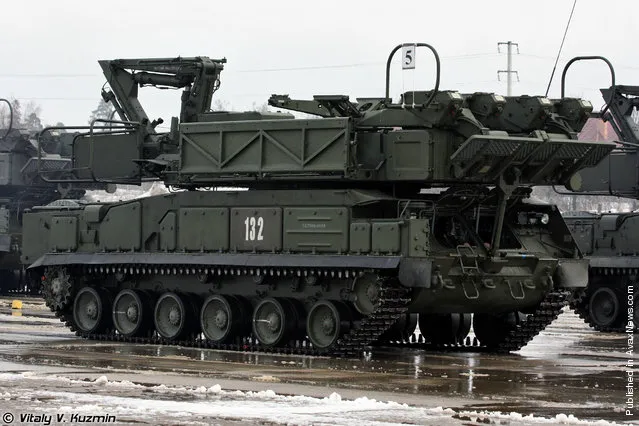
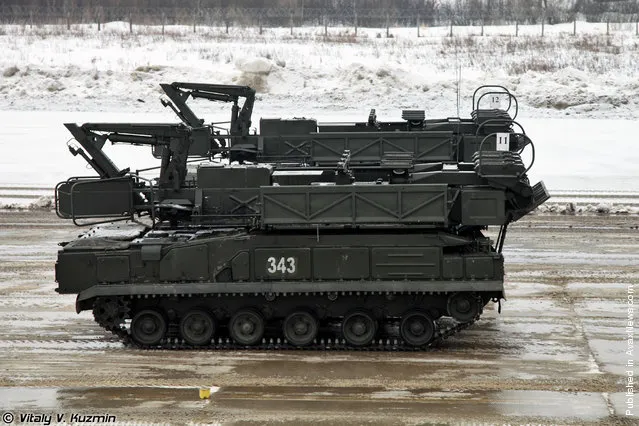
9A39M1 launcher-loader vehicle for Buk-M1-2 air defence system. The Buk missile system (beech) is a family of self-propelled, medium-range surface-to-air missile systems developed by the former Soviet Union and Russian Federation and designed to engage cruise missiles, smart bombs, fixed- and rotary-wing aircraft, and unmanned aerial vehicles.
The Buk missile system is the successor to the NIIP/Vympel 2K12 Kub (NATO reporting name SA-6 “Gainful”). The first version of Buk adopted into service carried the GRAU designation 9K37 and was identified in the west with the NATO reporting name “Gadfly” as well as the US Department of Defense designation SA-11. Since its initial introduction into service the Buk missile system has been continually upgraded and refined with the latest incarnation carrying the designation 9K37M2 “Buk-M2”. (Photo by Vitaly Kuzmin)
The Buk missile system is the successor to the NIIP/Vympel 2K12 Kub (NATO reporting name SA-6 “Gainful”). The first version of Buk adopted into service carried the GRAU designation 9K37 and was identified in the west with the NATO reporting name “Gadfly” as well as the US Department of Defense designation SA-11. Since its initial introduction into service the Buk missile system has been continually upgraded and refined with the latest incarnation carrying the designation 9K37M2 “Buk-M2”. (Photo by Vitaly Kuzmin)
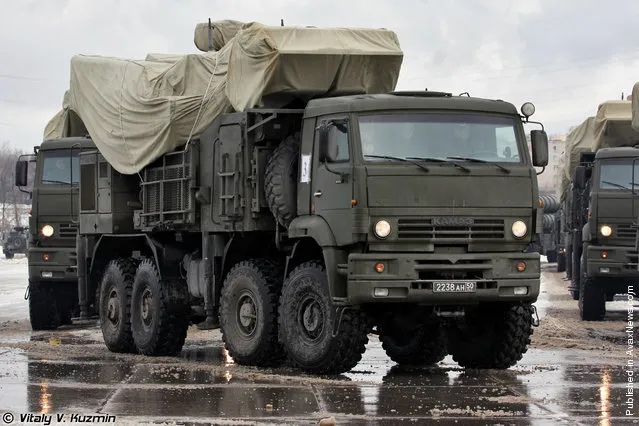
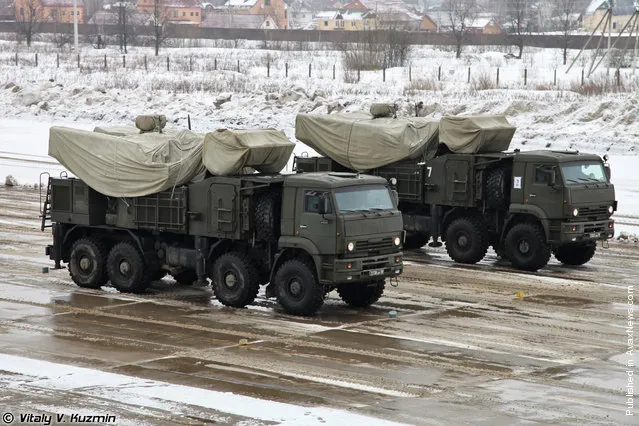
96K6 Pantsir-S1. Pantsir-S1 (NATO reporting name SA-22 Greyhound) is a combined short to medium range surface-to-air missile and anti-aircraft artillery weapon system produced by KBP of Tula, Russia. The system is a further development of SA-19/SA-N-11 and represents the latest air defence technology by using phased-array radars for both target acquisition and tracking.
It is a short to medium range ground based air defence system, wheeled, tracked or stationary with two to three operators. Its air defence consists of automatic anti-aircraft guns and surface-to-air-missiles with radar or optical target-tracking and radio-command guidance. Its purpose is protection of civil and military point and area targets, for motorised or mechanised troops up to regimental size or as defensive asset of higher ranking air defence systems like S-300/S-400. Aerial targets include everything with a minimum radar-cross-section of 2 cm2 to 3 cm2 and speeds up to a maximum of 1300 metre/second within a maximum range of 20,000 metres and heights up to 15,000 metres – including all types of aircraft, helicopters, unmanned aerial vehicles, cruise missiles and air-to-ground precision guided weapons. The system is able to defend against stealth aircraft. (Photo by Vitaly Kuzmin)
It is a short to medium range ground based air defence system, wheeled, tracked or stationary with two to three operators. Its air defence consists of automatic anti-aircraft guns and surface-to-air-missiles with radar or optical target-tracking and radio-command guidance. Its purpose is protection of civil and military point and area targets, for motorised or mechanised troops up to regimental size or as defensive asset of higher ranking air defence systems like S-300/S-400. Aerial targets include everything with a minimum radar-cross-section of 2 cm2 to 3 cm2 and speeds up to a maximum of 1300 metre/second within a maximum range of 20,000 metres and heights up to 15,000 metres – including all types of aircraft, helicopters, unmanned aerial vehicles, cruise missiles and air-to-ground precision guided weapons. The system is able to defend against stealth aircraft. (Photo by Vitaly Kuzmin)
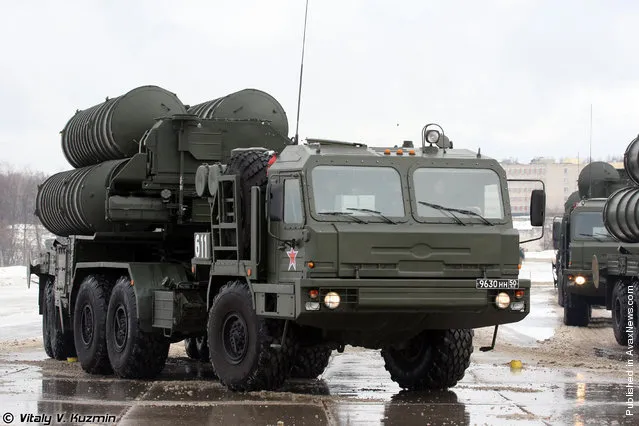
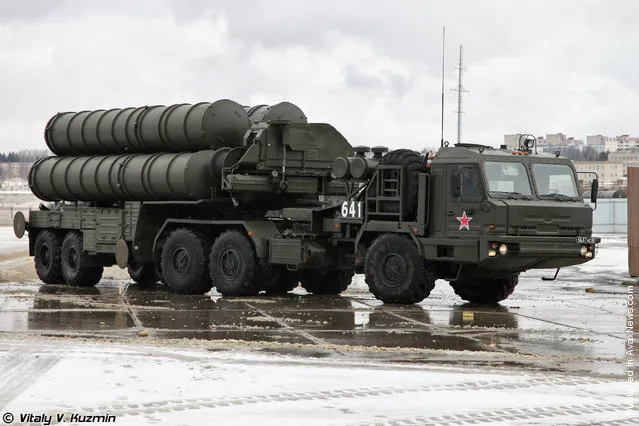
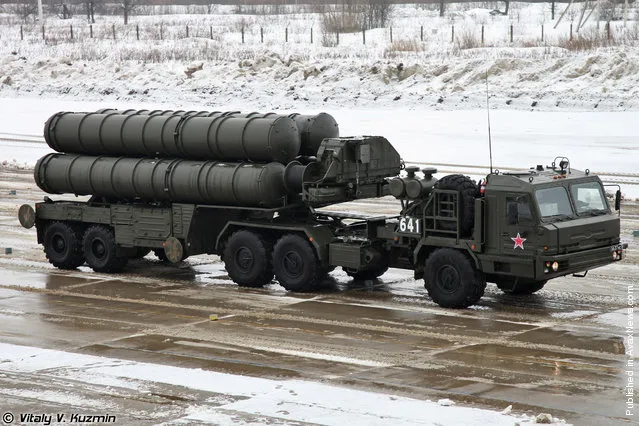
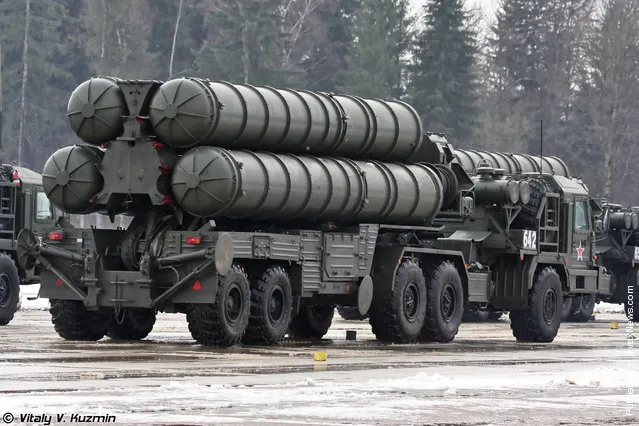
S-400 Triumf air defence system transporter erector launcher. The S-400 Triumf is a new generation anti-aircraft weapon system developed by Russia's Almaz Central Design Bureau as an upgrade of the S-300 family. It is currently in limited service with the Russian Armed Forces.
The S-400's NATO reporting name is SA-21 Growler, and the system was previously known as S-300PMU-3. Its claimed range is at least twice that of the previous S-300PMU system.
The S-400 uses 3 different missiles to cover its entire performance envelope. These are the extremely long range 40N6, long range 48N6 and medium range 9M96 missile. Each one has different capabilities.
The development of the S-400 system began in the late 1990s. The system was formally announced by the Russian Air Force in January 1999. On 12 February 1999, the first tests were performed at Kapustin Yar in Astrakhan which were reported successful. As a result of this, the S-400 was scheduled for deployment in the Russian army in 2001.
In 2003 it first became apparent that the system was not ready for deployment, but in August two high ranking military officials expressed concerns that the S-400 was being tested using 'obsolete' interceptors from the S-300P and concluded that it was not ready for production.
Finally the completion of the project was announced in February 2004. In April, a ballistic missile was successfully intercepted in a test of the upgraded 48N6DM interceptor missile. (Photo by Vitaly Kuzmin)
The S-400's NATO reporting name is SA-21 Growler, and the system was previously known as S-300PMU-3. Its claimed range is at least twice that of the previous S-300PMU system.
The S-400 uses 3 different missiles to cover its entire performance envelope. These are the extremely long range 40N6, long range 48N6 and medium range 9M96 missile. Each one has different capabilities.
The development of the S-400 system began in the late 1990s. The system was formally announced by the Russian Air Force in January 1999. On 12 February 1999, the first tests were performed at Kapustin Yar in Astrakhan which were reported successful. As a result of this, the S-400 was scheduled for deployment in the Russian army in 2001.
In 2003 it first became apparent that the system was not ready for deployment, but in August two high ranking military officials expressed concerns that the S-400 was being tested using 'obsolete' interceptors from the S-300P and concluded that it was not ready for production.
Finally the completion of the project was announced in February 2004. In April, a ballistic missile was successfully intercepted in a test of the upgraded 48N6DM interceptor missile. (Photo by Vitaly Kuzmin)
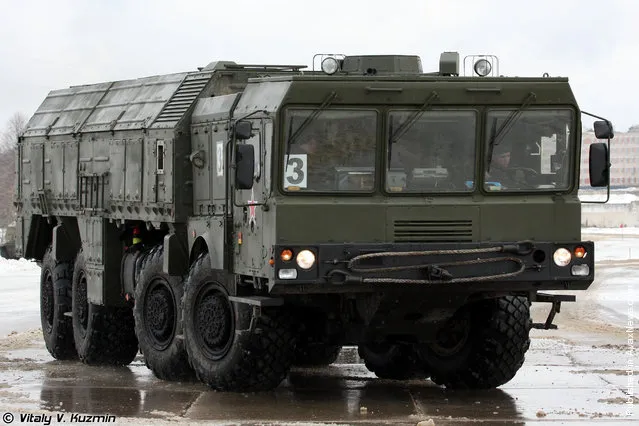
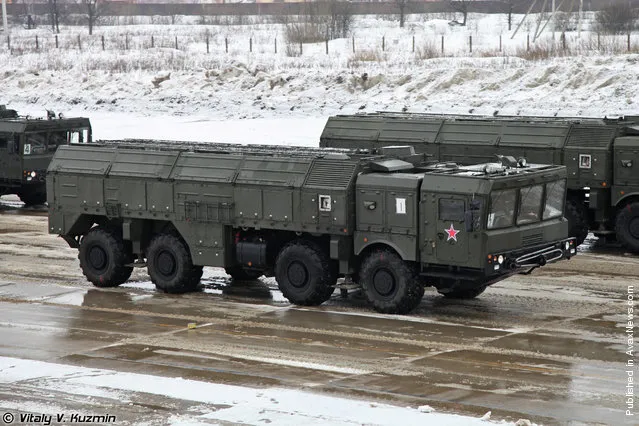
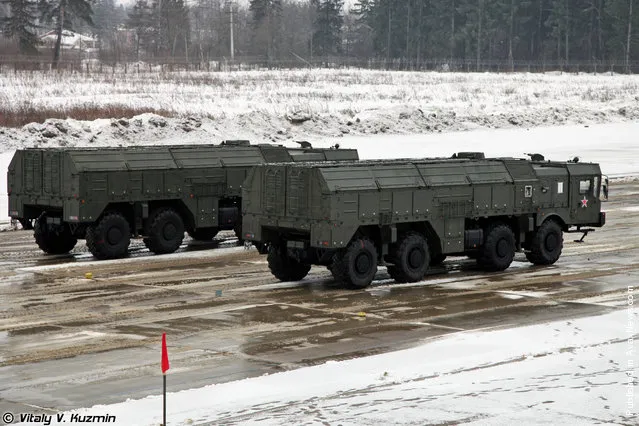
9P78-1 transporter erector launcher for Iskander-M system. (Photo by Vitaly Kuzmin)
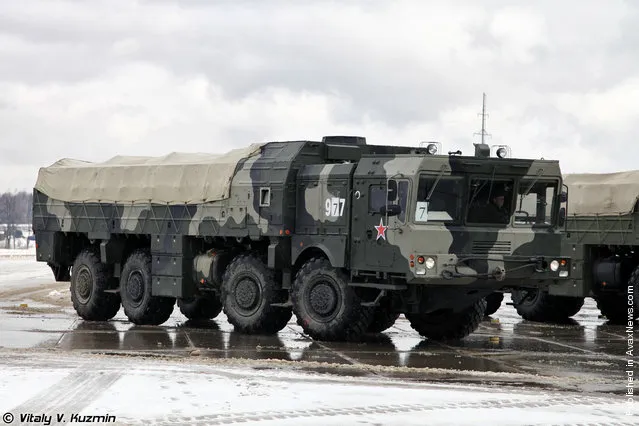
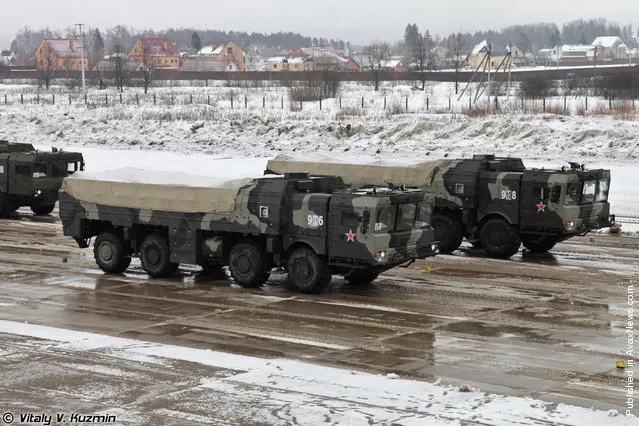
9T250 loading vehicle for Iskander-M system. The 9K720 Iskander (NATO reporting name SS-26 Stone) is a mobile theater ballistic missile system produced and deployed by Russia.
The Iskander ballistic missile is superior to its predecessor, the Oka. The Iskander-M system is equipped with two solid-propellant single-stage guided missiles, model 9M723K1. Each one is controlled throughout the entire flight path and fitted with a nonseparable warhead. Each missile in the launch carrier vehicle can be independently targeted in a matter of seconds. The mobility of the Iskander launch platform makes a launch difficult to prevent.
Targets can be located not only by satellite and aircraft but also by a conventional intelligence center, or by a soldier who directs artillery fire. Targets can also be located from aerial photos scanned into the computer. The missiles can be re-targeted during flight in the case of engaging mobile targets. Another unique feature of Iskander-M (not Iskander-E) is the optically guided warhead, which can also be controlled by encrypted radio transmission, including such from AWACS or UAV. The electro-optical guidance system provides a self-homing capability. The missile's on-board computer receives images of the target, then locks onto the target with its sight and descends towards it at supersonic speed. (Photo by Vitaly Kuzmin)
The Iskander ballistic missile is superior to its predecessor, the Oka. The Iskander-M system is equipped with two solid-propellant single-stage guided missiles, model 9M723K1. Each one is controlled throughout the entire flight path and fitted with a nonseparable warhead. Each missile in the launch carrier vehicle can be independently targeted in a matter of seconds. The mobility of the Iskander launch platform makes a launch difficult to prevent.
Targets can be located not only by satellite and aircraft but also by a conventional intelligence center, or by a soldier who directs artillery fire. Targets can also be located from aerial photos scanned into the computer. The missiles can be re-targeted during flight in the case of engaging mobile targets. Another unique feature of Iskander-M (not Iskander-E) is the optically guided warhead, which can also be controlled by encrypted radio transmission, including such from AWACS or UAV. The electro-optical guidance system provides a self-homing capability. The missile's on-board computer receives images of the target, then locks onto the target with its sight and descends towards it at supersonic speed. (Photo by Vitaly Kuzmin)
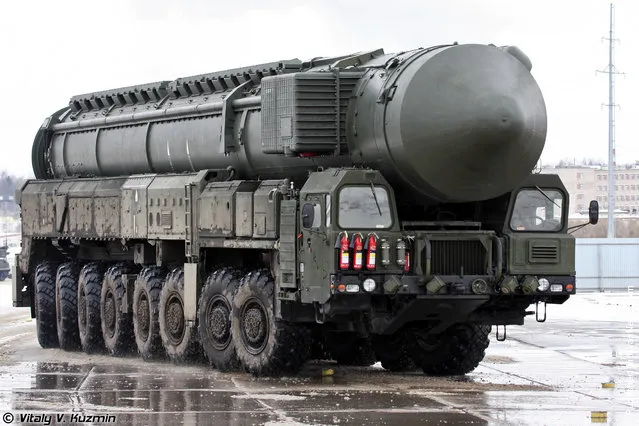
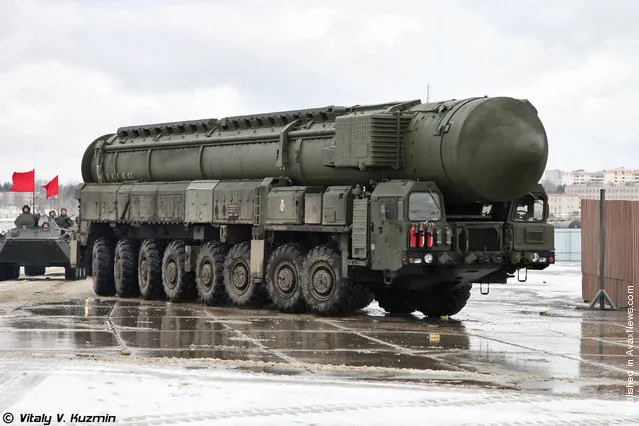
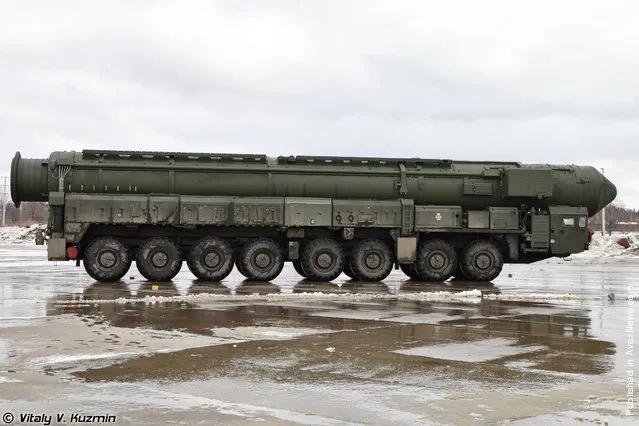
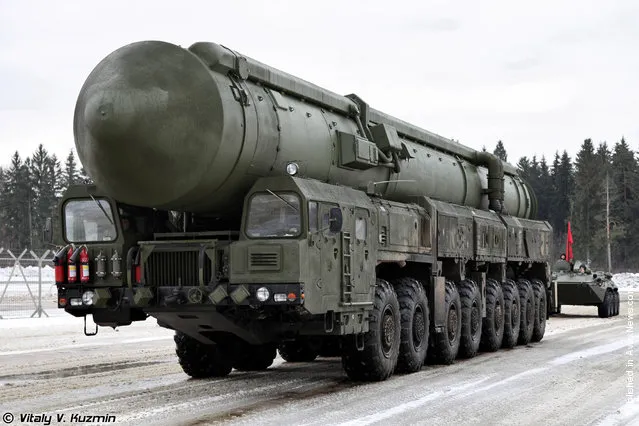
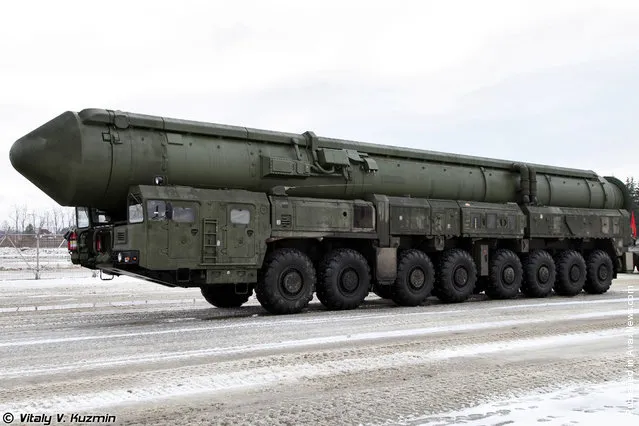
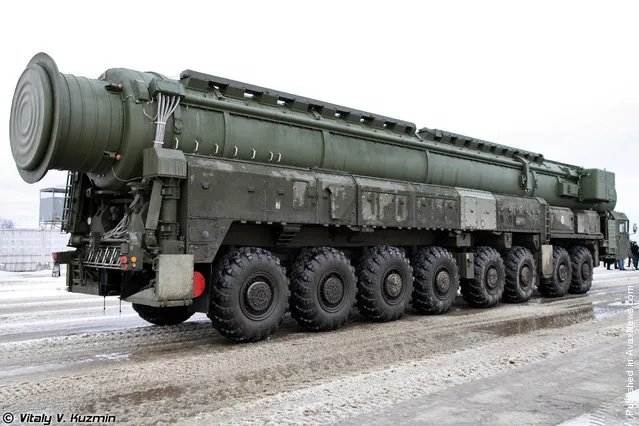
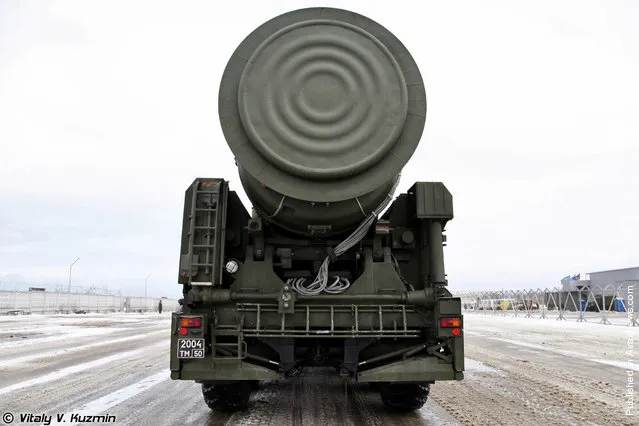
RT-2PM2 Topol-M TEL with presumably Yars system transport-launch container. The RT-2UTTKh «Topol-M» (Russian: РТ-2УТТХ «Тополь-М», NATO reporting name: SS-27 Sickle B, other designations: RS-12M1, RS-12M2, RT-2PM2) is one of the most recent intercontinental ballistic missiles to be deployed by Russia (see RS-24), and the first to be developed after the dissolution of the Soviet Union.
“Topol” in Russian means “white poplar”. It is designed and produced exclusively by the Moscow Institute of Thermal Technology, and built at the Votkinsk Machine Building Plant.
The Topol-M is a cold-launched, three-stage, solid-propellant, silo-based or road-mobile intercontinental ballistic missile. The missile's length is 22.7 m and the first stage has a body diameter of 1.9 m. The mass at launch is 47,200 kg, including the 1200 kilogram payload. Topol-M carries a single warhead with a 800 kt yield but the design is compatible with MIRV warheads. According to chief designer Yury Solomonov, the missile can carry four to six warheads along with decoys. Its minimum range is estimated to be 2,000 km and the maximum range 10,500 km. It has three solid rocket stages with inertial, autonomous flight control utilizing an onboard GLONASS receiver. It is reputed to have the highest accuracy of any Russian ICBM with a CEP of 200m. Body of the rocket is made by winding carbon fiber.
The Topol-M may be deployed either inside a reinforced missile silo, which is reported to be able to withstand a direct nuclear hit or from a APU 15U168 launcher mounted on the MZKT-79221 “Universal” 16-wheeled transporter-erector-launcher. This mobile launcher is capable of moving through roadless terrain, and launching a missile from any point along its route. The designation for the silo-based Topol-M missile is believed to be RS-12M2, while the mobile version is RS-12M1. (Photo by Vitaly Kuzmin)
“Topol” in Russian means “white poplar”. It is designed and produced exclusively by the Moscow Institute of Thermal Technology, and built at the Votkinsk Machine Building Plant.
The Topol-M is a cold-launched, three-stage, solid-propellant, silo-based or road-mobile intercontinental ballistic missile. The missile's length is 22.7 m and the first stage has a body diameter of 1.9 m. The mass at launch is 47,200 kg, including the 1200 kilogram payload. Topol-M carries a single warhead with a 800 kt yield but the design is compatible with MIRV warheads. According to chief designer Yury Solomonov, the missile can carry four to six warheads along with decoys. Its minimum range is estimated to be 2,000 km and the maximum range 10,500 km. It has three solid rocket stages with inertial, autonomous flight control utilizing an onboard GLONASS receiver. It is reputed to have the highest accuracy of any Russian ICBM with a CEP of 200m. Body of the rocket is made by winding carbon fiber.
The Topol-M may be deployed either inside a reinforced missile silo, which is reported to be able to withstand a direct nuclear hit or from a APU 15U168 launcher mounted on the MZKT-79221 “Universal” 16-wheeled transporter-erector-launcher. This mobile launcher is capable of moving through roadless terrain, and launching a missile from any point along its route. The designation for the silo-based Topol-M missile is believed to be RS-12M2, while the mobile version is RS-12M1. (Photo by Vitaly Kuzmin)
15 Apr 2012 12:50:00,
post received
0 comments
